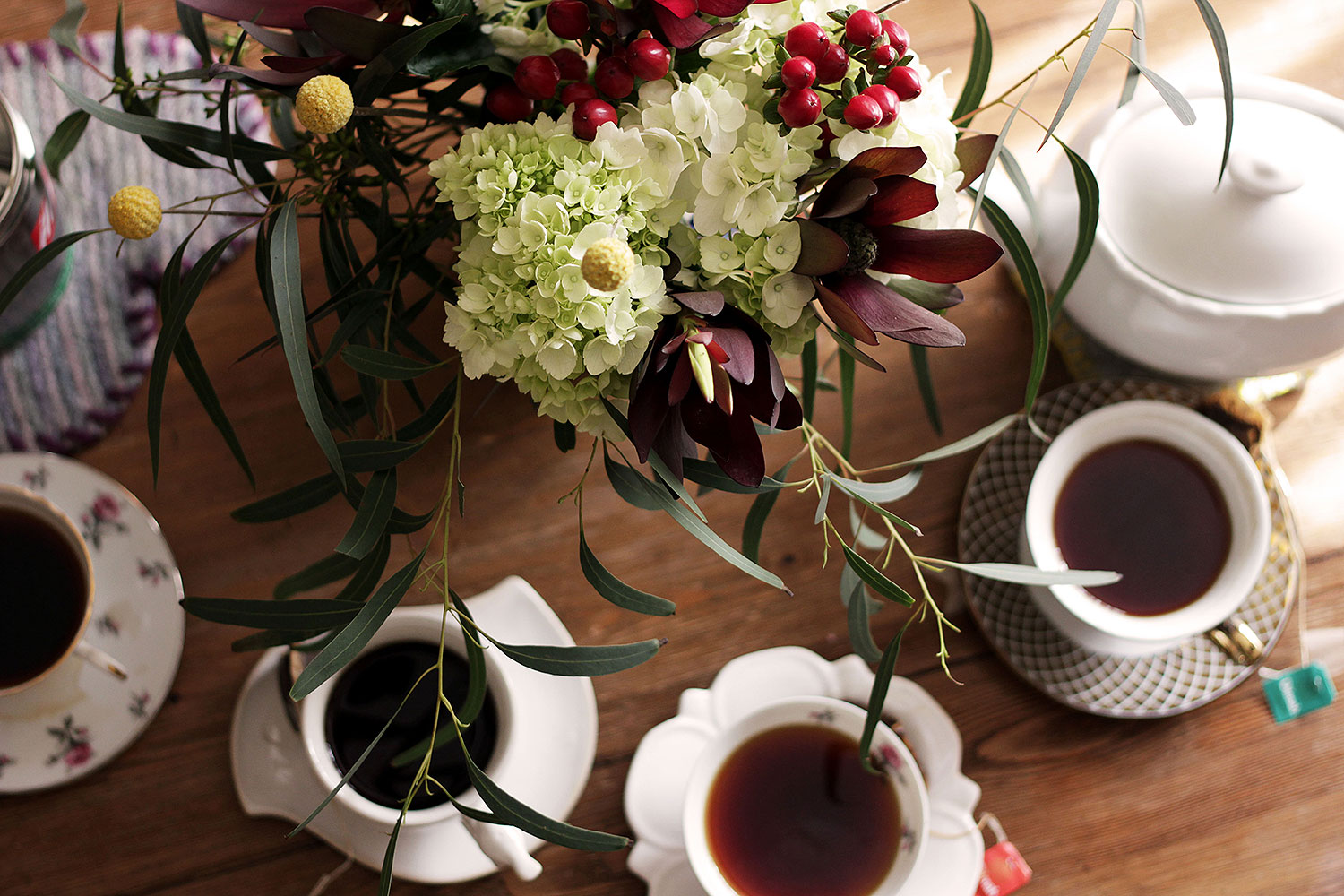English Breakfast, Irish Breakfast, English Afternoon… Why so many names when they’re all “100% Ceylon Tea”?
My husband gave me a box set of black teas for Christmas. I poured intently over the dozen-or-so varieties only to discover that, while the tea names varied, the labels all listed the same ingredient: 100% Ceylon Tea. The issue came up again this month: I am fueling my book tour with gallons of tea … and yet every cuppa is little more than a brew of 100% Ceylon Tea.
Isn’t the definition of insanity
Doing the same thing over and over again but expecting different results?
I had to find out what was going on.
My next move? A literal “pouring over” with hot water. Every morning I sipped a different tea only to remain perplexed: I couldn’t detect a noticeable difference in the teas. Feeling more and more duped, I decided to host an official tea tasting. And, since I wanted to be sure of the results, I did it with my husband and friend.

How to set up an accurate tea tasting:
Whether you’re trying teas from the same part of the world or multiple regions, a tea tasting is a great way to bring the world into your kitchen. Even the tiniest global citizens can enjoy a tea tasting to learn more about geography, weather patterns, and agriculture.
- Take small sips. A tea tasting is a lot like wine tasting. While wine tastings can cause tipsy tipplers, caffeine jitters can be a minor issue at tea tastings (unless you’re tasting caffeine-free tea, in which case even the youngest family members can participate).
- Brew times are critical. Check packaging for suggested brew times. While water is heating up, place the tea bags in the cups. Boil enough hot water to fill all the cups and add it in quick succession. Set a timer for exact brew. Remove the tea bags starting with the one that got hot water first.
- Sniff coffee grounds. Everything can start to taste the same after a while. Sniff coffee grounds to clear you palate (drinking water can help, too).
The Results
My official panel of tasters included myself, Keith (thanks to his extra sensitive palate that once earned him the nickname Mr Picky), and my friend Alex.
English Afternoon
Description on the package: Medium strength, delightful bouquet
English afternoon is astringent and finished with a sharp high note – a little bit like the bite of a citrus peel.
Irish Breakfast
Description on the package: Deep color, extra strength
If Irish breakfast tea was musical, this tea would be the deep bass. I thought it had a pleasant vegetal note – rather like steamed artichokes and I’m certain the extra strength would be welcome on dreary mornings. Alex and Keith disagreed, noting that the mouthfeel was “rough” with a heavy bitterness and the astringency of unripe banana peel.
English Breakfast
Description on the package: Rich, strong, full bodied
Full, round, with a suspicion of vanilla, English Breakfast was the crowd favorite. If you’re looking for a smooth wake-up call, a pot of English Breakfast is a sure bet.
Earl Grey
Description on the package: Medium strength, deep tone, delicate fragrance of Bergamot.
Just for fun, we added Earl Grey to the mix of teas we tasted. The package also claims 100% Ceylon, with the added fragrance of bergamot oil (a fruit in the citrus family also dubbed “sour orange”). To me the flavor is piney and quite floral. As far as the Ceylon Tea goes, Earl Grey tastes of mist and dreams, just as the name indicates.
How can there be a difference when it’s all Ceylon Tea?
Call me crazy, but even after the taste test I remained unsatisfied. How could there be a difference when the ingredient labels are exactly the same?
Turns out much of a tea’s flavor has to do with where it is grown and how it is processed. Ceylon Tea indicates tea grown in Sri Lanka. According to Dilmah Tea:
Only strength and tone vary, depending on the elevation of tea gardens above sea level in low, mid and high grown regions. Each region has it’s own distinctive character.
Traditional tea, made in the ‘orthodox’ style – a production process that starts with handpicking the leaves and continues through withering, rolling, oxidation and firing – follows a technique perfected over centuries. It produces tea that are varied and sophisticated.
Single Origin Tea – unblended tea – is important because one of the most desirable features in tea is terroir – the sense of place. Terroir dictates that tea grown in the Uva region at a certain time of year, possesses the unique, signature taste that is the product of that unique climatic phenomenon. It gives each valley, each region and each country its unique identity in tea. The lower cost option though is to buy tea from wherever it is cheap – for tea varies enormously in cost – and blend it all together to produce a ‘multi-origin blend’. That may work for coffee, but certainly not for tea.
Turns out I may not be crazy to expect different results from the teas – after all they aren’t exactly the same. So, if you’re using 100% Ceylon the variation comes from the terroir (similar to wine). Just because most wine is made with grapes doesn’t mean every bottle tastes the same!
Ok, got it! Let’s sip some tea… perhaps with some cream and currant scones!









12 Comments